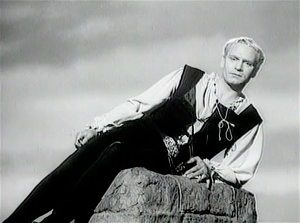For my Blog Post I´ve chosen Act 3, Scene 1 from Olivier´s Hamlet (1948) and Zeffirelli´s Hamlet (1990). This scene shows one of the most famous Shakespeare soliloquies.
The reason why I chose these two directors is because they each use very distinct approaches. Olivier, as a man of the theater, defines his productions of Shakespeare films by choosing stage elements and combining them with old theatrical roots. Zeffirelli, on the other hand, brought Shakespeare films closer to Hollywood and casted well known stars like Mel Gibson, which was followed by a big success. It was the start of Shakespeare films for a broader cinematic audience. Based on concrete examples, I will cover the contrasts between their directing styles later in this comparison.
What I have briefly introduced above goes hand in hand with my intention for picking a soliloquy for the scene comparison. Soliloquies are fundamental elements used mainly on stage. It has often been discussed if the film genre is suitable for soliloquies as stage conventions need to be adapted to the screen, and therefore directors have to make really careful decisions about how to present soliloquies. Samuel Crowl acknowledges in his book Shakespeare and Film a Norton Guide (2008) that “…soliloquy is a convention foreign to film.” In film, it is unusual that actors address the audience directly, and on screen, it is not possible to achieve that intimacy between those two levels. Nevertheless, there was no other way for directors to not include soliloquies in their films because Shakespearean texts contain several soliloquies, which are central passages. Filmmakers found different solutions to solve the problem of how to translate a soliloquy into the language of film, one of which, is the voice-over.
Now I want to move on from the theoretical framework to a more concrete analysis of this specific element. First, I want to start with picturing how Olivier dealt with the soliloquy in his screen adaptation of Hamlet. Secondly, I am going to illustrate Zeffirelli´s film and draw comparisons between the two versions of the same scene.
Act 3, Scene 1 starts in Olivier’s film with music that is in my opinion irritating but matches perfectly with the fast motion shot, when the camera moves quickly up the stairs in semi-darkness. Up on the top of Elsinore the camera captures the breaking waves down at the shore, and Olivier has chosen this landscape in order to link the visual images to Shakespeare´s lines “to take arms against a sea of troubles,/And by opposing end them” (Crowl 2008, 24). After this line Olivier switches to a voice-over, which is an element of film often used instead of a soliloquy and works exclusively on screen. Hamlet holds his eyes closed during the voice-over. Again, this is another example where Olivier combines the words and the images perfectly, as Hamlet talks about dying and sleeping, all of which are related to closed eyes. At the moment when the line “…perchance to dream” gets spoken again and the voice-over stops, Hamlet opens his eyes again as if he awoke from dreaming.
The most impressive moments of this scene happen towards the end when Hamlet faces the camera directly two times. For me it was quite irritating but it gave me the feeling of being closer to the actor and that he addressed me directly with his internal struggle.

This same scene has been done differently by Zeffirelli. As already mentioned, he creates a unique version contrasting Olivier´s. Mel Gibson plays Zeffirelli´s Hamlet in a very energetic and emotional manner. At the beginning of Act 3, Scene 1 the Italian director chose a close-up that exposes anxious eyes. As opposed to Olivier Zeffirelli´s Hamlet did not look directly into the camera. Moreover Zeffirelli left out any film score in this scene and there is also no voice-over. It is only Hamlet speaking with a soft voice at the beginning but his voice gets more wavering and louder because of reverberation as he walks down into the tomb. The silence in the tomb makes Hamlet´s soliloquy even more impressive in my opinion – no breaking waves disturb his verse. The last thing I want to mention is that Zeffirelli chose this dark tomb but lets the sun break through several times maybe as a sign of hope and optimism.
To sum up, soliloquies are not easy to translate into the language of film but directors such as Olivier and Zeffirelli managed to create very successful versions.
Works Cited
Crowl, Samuel. Shakespeare and Film: A Norton Guide. NY: W.W. Norton & Co., 2008.
Leave a Reply
You must be logged in to post a comment.